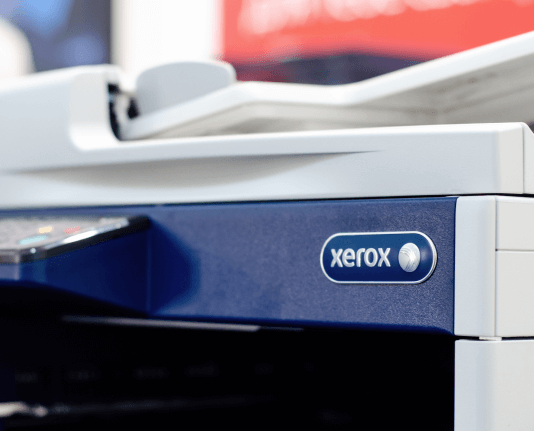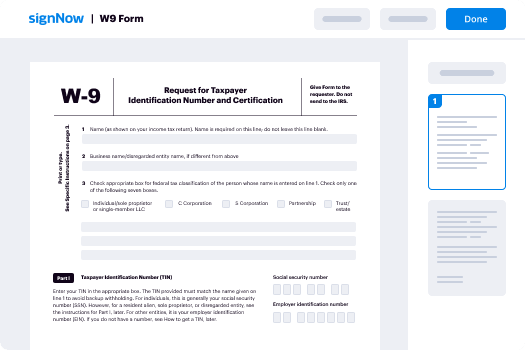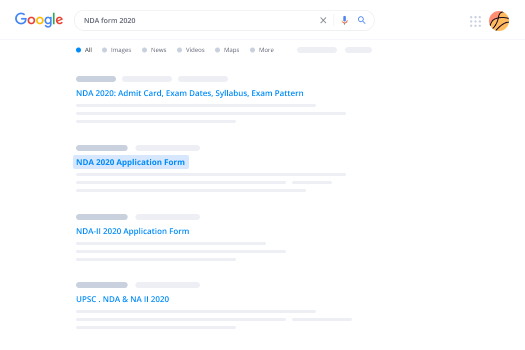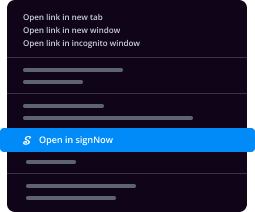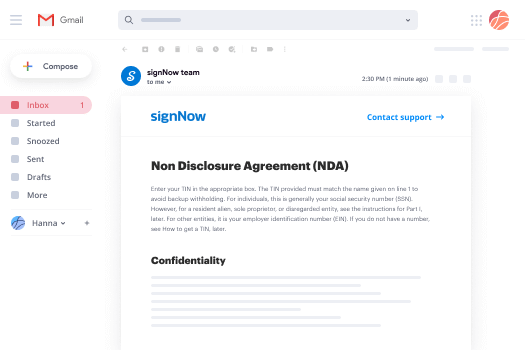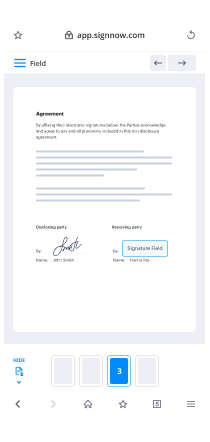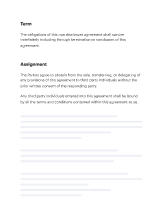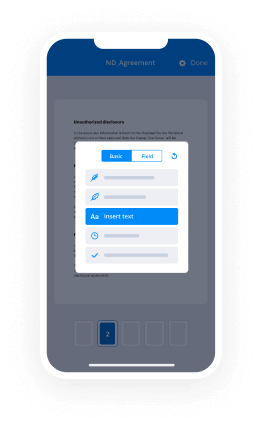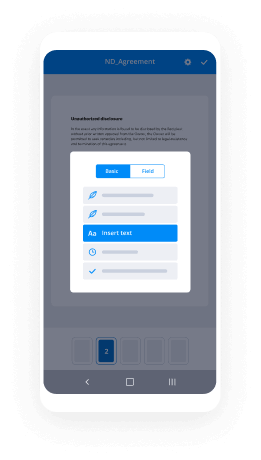Help Me With Add eSign in Box
Contact Sales
Make the most out of your eSignature workflows with airSlate SignNow
Extensive suite of eSignature tools
Robust integration and API capabilities
Advanced security and compliance
Various collaboration tools
Enjoyable and stress-free signing experience
Extensive support
Keep your eSignature workflows on track
Our user reviews speak for themselves






How to use box signing with airSlate SignNow
Are you in search of an effective method to handle electronic signatures? airSlate SignNow provides a smooth solution to box signing and manage your document requirements effortlessly. This tutorial will guide you through the process of getting started with airSlate SignNow and examine its diverse advantages for your enterprise.
Instructions for box signing with airSlate SignNow
- Launch your chosen web browser and go to the airSlate SignNow website.
- Create a new account by registering for a free trial, or log in if you already possess an account.
- Choose the document you intend to upload for signing or sending.
- If you wish to utilize this document multiple times, think about converting it into a template for future reference.
- Open your document and make necessary adjustments: add fillable fields or enter required details.
- Sign the document yourself and assign signature fields for others who need to provide their signatures.
- Click 'Continue' to set up and send an invitation for electronic signature.
Employing airSlate SignNow not only streamlines the signing process but also boosts your business's productivity with its intuitive interface and powerful features. It is tailored to meet the needs of small to mid-sized enterprises, making it a superb choice for document management.
Ready to revolutionize your document signing experience? Begin your free trial today and discover the benefits of airSlate SignNow. With transparent pricing and outstanding 24/7 support, your business can flourish effortlessly.
How it works
Rate your experience
-
Best ROI. Our customers achieve an average 7x ROI within the first six months.
-
Scales with your use cases. From SMBs to mid-market, airSlate SignNow delivers results for businesses of all sizes.
-
Intuitive UI and API. Sign and send documents from your apps in minutes.
A smarter way to work: —how to industry sign banking integrate
FAQs
-
What is box sign in and how does it work with airSlate SignNow?
Box sign in allows users to securely access their airSlate SignNow account using their Box credentials. This integration streamlines the document signing process, making it easy to import files directly from Box and send them for eSignature. By utilizing box sign in, businesses can enhance workflow efficiency while maintaining security.
-
Are there any fees associated with using box sign in on airSlate SignNow?
Using box sign in to access airSlate SignNow is included in the overall subscription plan, so there are no additional fees specifically for this feature. Pricing varies based on the plan you choose, but all plans offer the convenience of box sign in. Check our pricing page for details on the most cost-effective solutions.
-
What features are available with box sign in on airSlate SignNow?
With box sign in, users can easily access their documents stored in Box and utilize airSlate SignNow’s eSignature capabilities. Key features include document templates, automated workflows, and detailed audit trails, all accessible through box sign in. This integration enhances productivity by allowing seamless document management.
-
Can I use box sign in on mobile devices?
Yes, you can use box sign in on mobile devices through the airSlate SignNow app. This feature allows you to access your documents and send them for eSignature directly from your smartphone or tablet. Enjoy the convenience of signing documents on the go with box sign in.
-
How does box sign in enhance security for my documents?
Box sign in enhances security by allowing users to authenticate their identity through Box’s secure login process. This means that your documents remain protected with high-level encryption and access controls. By using box sign in with airSlate SignNow, you can ensure that only authorized users can access, sign, and manage your sensitive documents.
-
What are the benefits of using airSlate SignNow with box sign in?
Using airSlate SignNow with box sign in offers numerous benefits, including streamlined access to your documents and the ability to send them for eSignature effortlessly. This integration saves time and reduces administrative overhead by simplifying the signing process. Plus, it enhances collaboration among team members who can easily share and sign documents from Box.
-
Is box sign in suitable for businesses of all sizes?
Absolutely! Box sign in is designed to cater to businesses of all sizes, from startups to large enterprises. With flexible pricing plans and a range of features, airSlate SignNow's integration with box sign in can accommodate your specific business needs, making it a versatile solution for managing your document workflows.
-
What is the most efficient way of studying to score a 700 on the GMAT?
I took the GMAT on the 12th of May, 2016 and ended up getting a score of 760. Here is a detailed debrief which may help you prepare for the GMAT. Feel free to get in touch with me in case you need help with your GMAT prep.Practice Materials Used:Verbal:1. Sentence Correction: Manhattan,Aristotle Prep2. Critical Reasoning:Manhattan, Powerscore CR Bible (few chapters)3. Reading Comprehension: GIN’sRC notesQuant:1. Manhattan BooksOthers:1. Kaplan 8002. Official Guide 133. Official Guide 164. Official Guide forVerbal 16Forums:1. GMATClub2. Manhattan3. BeattheGMATApps:1. Veritas Question Bank2. Manhattan AppFor SC, the Manhattan Book is without doubt the best there is. I used a couple of days right at the start of my prep to go through all the rules. I also used Aristotle Prep to supplement my understanding of the rules. According to me, this worked better than simply re-reading the Manhattan Book, as a different approach with varied examples helped drill the rules in my head better. I also completed all questions from OG13 and OG Verbal 16 Guide, and the tougher questions from OG16.For CR, I again referred to the corresponding Manhattan Book. I found it useful in helping me break down the argument. I also used the Powerscore CR bible which is undoubtedly a great book. However, I wanted to practice more questions instead of reading theory again and hence I left the book midway. I practiced mainly from OG 13, OG 16 and OG 16 Verbal Guide.For Reading Comprehension,I found this incredible document called ‘Gin’s RC Notes’ on GMATClub. It certainly helped me in comprehending the passages better. Practice materials were the same as the ones used for SC and CR.As regards Quant, I didn’t spend a lot of time reading theory. I simply went through all the Quant Manhattan Guides in 2-3 days.I also used the Kaplan 800 book to revise all topics. The book is quite good for revision and for practice.I also maintained a notebook to record my answers and to write down key points. Sample shown below:Mock ScoresAs can be seen from the mock scores, I was pretty ok at quant. However, I realized that my verbal performance was way below par and hence decided to almost entirely focus on verbal from that point on.My performance in the last mock was quite good and that score convinced to register for the GMAT. I checked the test center calendar and scheduled my GMAT on 12th May,2016.Manhattan: In my opinion, the quant section in these mocks is way tougher than the one in the actual exam. As can be seen from the pic, my performance in quant in the first mock was a fiasco. However, once I started getting used to the difficulty, I got better at it. The verbal section is a pretty good representative of the section in the actual exam.Veritas: I found the quant section in the Veritas mocks to be ridiculously simple. The verbal questions were fairly difficult and are a bit different as compared to Manhattan. I would suggest taking a few mocks of Veritas in addition to Manhattan just to get a different perspective of verbal questions.GMAT Prep: The best indicator of your current level as can be seen from the fact that my final score was a neat average of my 2 GMAT prep mock scores.Test Day Experience:My test slot was at 9 am. To avoid the deadly Mumbai traffic, I decided to head out early and signNowed the test center at 8 am itself. Since, the test center was closed, I had to wait till 8:30 before I was allowed inside. The formalities were completed quickly post this and the friendly people at the center allotted a computer to me.AWA: I breezed through the instructions and started with AWA. The argument was simple and it didn’t take me much time to find out the flaws in the argument. I took around 5 minutes initially to frame the structure and took nearly 15 minutes to type in the entire thing. I spent a few more minutes proof-reading the entire essay before submitting it.IR: I had hardly prepared for the IR section. All that I practiced were the questions from the practice tests. On the whole, the questions in this section were not too difficult.However, I got bogged down on one particular set with a lot of data and hence couldn’t answer the last question in this section.Quant: The first 3-4 questions were extremely simple. However, post this I started getting a few tricky ones. Most of the mistakes I made in my mocks were in DS and so I forced myself to take a little more time to check for all conditions in DS questions.Few of the questions around Q.20 ate up a lot of time and so I had to rush a bit at the end. The questions from Q.30 onward were not that difficult because of which I thought I had screwed up the Quant section. Finished the section with around a minute to spare.Verbal: Similar to quant,the first few questions were straight forward and I could spare a little more time double checking the answer. By the time I was done with Q.10, I had spent only 15 minutes and so I was bang on time to finish the section before time.Unfortunately, I got distracted by another candidate who seemingly had started off with test at that point in his time and who seemed to be venting his anger on the keyboard. The noise from his typing completely threw me off-guard and as I had not taken earplugs, I simply tried to concentrate harder. The next 10 odd questions took me a lot more time. At the end, I had 10 minutes remaining with around 6 questions to go. These questions were moderately difficult and I could finish the test with time to spare.Score: I was worried about my quant score but I genuinely thought I had done well in verbal. However, when I saw the score (760 with 50 Q and 44V) I was a bit disappointed. I had expected a 780 score especially considering my performance in the last mock. I was however relieved to know that 760 is still a 99th percentile score.Strategy Advice - My 2 cents:Problem Solving: Surely the easier section in Quant. It is pretty easy to get almost all questions right in PS with the right preparation and strategy. Also, in PS you have the added advantage of either eliminating options or choosing appropriate numbers. A good way of getting better is to try solving every question (wherever possible) using options in addition to the normal way of solving. The more numbers of ways you have to solve a question, the quicker you can kill it during the exam.Data Sufficiency: The major headache for me in Quant was in DS and it is probably the key to getting a 50/51 in Quant. In the initial few mocks, I kept missing simple traps (e.g. The number need not be an integer, for comparison of numbers include fractions as well, etc.). As I solved more questions, I got better at it. With practice this section can be easily cracked. I would suggest checking Bunuel’s problems at GMATClub which are segregated neatly topic-wise.Sentence Correction: This is the major bugbear for candidates. At the same time, this is the section in which the most improvement can be made. I went from around 10 wrong in SC in my first mock to all correct in my last 2 mocks. The easiest way to improve in this section is to analyze the errors you are committing and try and eliminate those. My strategy was to search for the question on Manhattan Forums and check if there was an explanation by Ron. I usually found his explanations to be the best. The second best resource was GMATClub. I would try and check if there was an explanation by an expert in that thread. Only if I understood the logic would I move on to the next incorrect question.Critical Reasoning: The Manhattan book was useful in delineating the different types of questions asked. The thing with Critical Reasoning is that the more questions you solve, the better you get. I concentrated on solving questions from all possible sources. I exhausted all questions from the OG13 as well as from OG16 Verbal. I also solved almost all questions from the Manhattan App (which is free for a limited time period) and from the Veritas Question Bank.Reading Comprehension: In the first few mocks, my abysmal performance in SC hid the fact that I was making errors in RC as well. However,in the later ones, I realized I was making at least 1 error per RC. Wanting to improve on this, I searched for a few RC strategies online and found the brilliant Gin’s RC Tips on GMATClub. The point which helped me the most was the part about agreeing or disagreeing vehemently with the author. This helped me grasp the RC better and solving the questions post that was an easy task. I would recommend everyone to check the document out.Parting thoughts:1. Don’t overdo the prep: Since I had less time to take the GMAT, I went a bit overboard with my prep initially. I solved the entire CR of OG in a day and had CR phobia the next few days. So my suggestion is to take it easy and to stop studying if your mind is exhausted.2. Get accustomed to the exam: Try and mimic the actual GMAT as much as you can. Solve the AWA and IR section as well wherever possible. Take the obligatory breaks if you want and eat the same stuff you would eat during the final exam.3. Keep a pair of earplugs with you as standby: The good folks at the Mumbai center provided me with one. However, since I had never taken an exam with earplugs, I didn’t find it necessary. However, the inside of the test center is pretty quiet. So any noise made by any candidate is amplified many fold and could distract you from the exam. Having the earplugs would be handy in such a case.4. Enjoy the experience: Enjoy the prep as much as you can. If you enjoy what you are doing, things get a bit easier. If you are someone who usually doesn’t perform well under pressure, then try and diminish the significance of the exam as much as possible. For example, forcing yourself to think that the GMAT is simply one component of the selection process will probably reduce the significance of it in your mind. This may help you be more relaxed during the test.5. Be patient if you feel your prep isn’t going anywhere: I’ll end with this point about patience. During my prep, in the initial few mocks, I was stuck in the 700-730 level. No matter how many questions I practiced, I kept getting questions wrong. However, once I kept at it, the mocks suddenly started showing results. As can be seen from the mock scores image, post Manhattan mock3, the scores kept increasing each time. So my advice is to keep at it even if you feel you are not improving a lot.The same message from Rahul Dravid - “My wife and I have built a new home with a lovely garden which houses lovely bamboo trees. I got reading on the Chinese bamboo and learned that the tree takes 5 years, 3 months to grow to its whole height of 80 feet. Yet, for the first 5 years, you only see a tiny green shoot, but in the next 90 days, it grows into a full-fledged tree. But in those first 60 months, it is growing its strong network of roots underground,to support the tree. In an era of instant gratification, we settle for shorter trees, but remember patience has its reward. These are your years of growing that strong network of roots but be sure when you finally achieve your success, people will call it “overnight success”. If only they knew of the Chinese bamboo!”All the best!P.S: I also teach aspirants for the GMAT. If you are interested, then do mail me at sriramk1986[at] gmail.com
-
Why did Peter Thiel get China so wrong?
Peter Thiel published Zero to One in 2014. In Chapter 6, Thiel presents a quadrant chart:Thiel argued back then the reason China is creating copycat tech products is that the country has a “definite pessimist” view.Here’s an excerpt of what he said:China is probably the most pessimistic place in the world today. When Americans see the Chinese economy growing ferociously fast (10 percent per year since 2000), we imagine a confident country mastering its own future. But that’s because Americans are still optimists, and we project our optimism onto China. From China’s viewpoint, economic growth cannot come fast enough. Every other country is afraid that China is going to take over the world; China is the only country afraid that it won’t.Thiel asserts savings are an all-time high and investments an all-time low in this quadrant. However, Thiel didn’t seem like he knew much about the subtle details of China back then. I can tell you in Chinese culture, thrift, savings and good money management skills are pretty well ingrained habits, whether you’ve read a book by Confucius or not.The credit environment is also less loose (need high downpayment for homes), low pension coverage, growing healthcare/education costs, former one child policy (children are essentially your retirement fund in China, less children=more reliance on savings) etc. It seems pretty rational to save. This is not a byproduct of “pessimism” towards the future.On the contrary, they are quite optimistic about the future. Just mention AI or some new tech, add in some form of reputation/authority, and they will be all over it. I think sometimes some people are “too optimistic”. Chinese venture capital invests a huge amount on venture deals in both the US and China already. Morale is high. These are moonshot deals that require a lot of “optimism”. I have several CIOs signNowing out to me out of the blue every month. There’s also a bunch of infrastructure and housing developers built. It takes a lot of optimism to build where there is no determined demand. (See: under-occupied developments in China)I will say it’s not all “optimism” either, so it’s really simplistic to put countries in boxes like this. If you consider their rational awareness of vulnerability to a resource shock in terms of price and access, it is not entirely wrong to say China is “pessimistic” about it. Policymakers do take measures though to mitigate risks and make deals to ensure safety. They are also quite lucky that commodities are priced relatively low currently.Here’s what Thiel has to say about China’s growth model:The easiest way for China to grow is to relentlessly copy what has worked in the West. And that’s exactly what it’s doing: executing definite plans by burning ever more coal to build ever more factories and skyscrapers. But with a huge population pushing resource prices higher, there’s no way Chinese living standards can ever actually catch up to those in the richest countries, and the Chinese know it.The first sentence is truth. The easiest way to improve upon what has already been done is to look at what mistakes the first mover has made and execute in your home turf, where you know the streets better. This is what the US did in their early years (and some domestic US startups still do this today, in fact they “copied” the idea of e-scooters rentals using QR codes from China). China does it slightly differently through a variety of methods (you can’t just mindlessly “copy”). It’s not just China either. That happens in many other countries, such as India. Actually, I’d say a very good amount of “innovation” is still being done like this.However, I suspect Thiel did not account for the role of politics in China and how well they understood technology relative to our government. Just look at the old people questioning Mark Zuckerberg in the hearing. If you told them you had a coffee next to your computer and Facebook would show you ads about coffee cup holders, they would probably believe you. In other words, they see technology as something that can magically work the way you want by telling what the software “wizards” can do. Same thing with cryptocurrency. You just can’t ban it to make it go away, otherwise you end up losing a seat at the table. Fortunately, some key regulators are willing to listen to the innovators first in the US before jumping to conclusions, so I won’t judge them until they make their moves, but it does show how much they know in general.In contrast, if you look at what Xi reads, you can tell he is a lot more familiar with technology and realises it’s not so simple as telling what you can and cannot do alone. This helps speed up what can be done very drastically, while we are still in gridlock with regulators, domestic patent infringers and domestic patent trolls bleeding cash and resources. A simplistic way to compare the speed is to look at patent lawsuits. In China, it takes 10 months or so and costs $250k. A patent lawsuit in the US takes 5 years or more and costs several millions of dollars. (Much more to patent law, such as injunctive relief.)“Copying” is low hanging fruit - but consider a lot of Chinese policies are quite experimental in nature and the politicians that get to office are not elected, they are promoted as technocrats. It takes a lot of innovation on policymaking to get to the top with a strong track record. That’s not to say it’s all merit because connections do matter, but at least a good amount of merit is involved. Public opinion also is truly taken as feedback and incorporated into policymaking. We don’t have that luxury here, corporate lobbying has a lot more say on whether there will be a status quo.Officials also knew from the start that they needed to innovate or they would never get out of the “middle income trap” that Thiel is essentially describing. They’ve been worrying about the innovation pipeline for a decade or more, and have been taking steps from building infrastructure to revising patent laws with strong political will. I recall back then in China it was an issue, and it is still one high priority today. That being said, it has been successful to some extent when you consider there is unmatched infrastructure for electronics manufacturing in Shenzhen and a large number of patents on par with developed countries. A lot of the software for ML is on par with the US, with larger data sets for models to work. They are also way ahead on adoption for mobile payments.When AI/ML started to catch on big, then people started realizing it was only a matter of time it would shift to China and it started becoming more clear that China has a good chance at passing the infamous trap. Even Thiel acknowledged the AI/ML trend himself. The sheer data advantage and government coordination is huge. You don’t necessarily need something entirely new or the highest concentration of “best” talent alone. You only need to make it work with what you have, and often the biggest roadblocks is not the top tech talent alone, but government/adoption to create the incentive in the first place. Just look at something like self-driving cars - the hard part is really getting enough data and remove unnecessary adoption roadblocks. Another example, facial recognition to prevent retail theft (especially the type by organized crime).The system is so favourable for innovation - even foreign companies (including US owners) prefer to use China as their patent court venue today. The strategy seems to be for China’s transition to high value manufactured goods and IP as labour prices increase, while opening up trade to other countries and ramping up domestic demand. A good amount of low-cost goods manufacturing have already moved to Vietnam, because labour costs are getting expensive, but the actual growth hasn’t really slowed that much compared to other members of BRICS. Chinese companies have so many domestic patents these days, and a good amount of foreign IP that is needed can be attracted with business incentives. That being said, the IP that China does not have good access to is advanced semiconductors, aeroplane manufacturing, defense, pharmaceuticals, agritech, power systems equipment, etc. There is still a long way to go, with no guarantees here.For the record, Zero to One contains more truths than myths about tech investments and the economy. I enjoyed Thiel’s book, even though it was quite apparent to me that he got China wrong at the time. I suspect he was basing this on 2012–2013 thinking though and remember this is not really a book on China. Personally, I think he hit on the US pretty accurately.Thiel has already realized he got it “wrong” with the quote “We now have startups here that are copies of things being done in China” (2018) and has indicated he is strategizing his Chinese investments recently. Thiel has also made regular visits to China these past several years. I’m fairly certain he has gotten up to speed by now.It’s also not fair for me to say a good amount of this after the fact. It is difficult to predict these actions in advance. There are always some signs, a good amount of which I did recognise because of my proximity to my uncle’s policymaking in tech for this instance, few can really get every single thing right in advance in the right magnitude and direction. Although it was growing fast to begin with, I certainly wasn’t expecting China to be fast as it is now with tech back in 2012.
-
Who are the best digital marketers, web developers, or software developers?
Short Answer - The ones who put in a lot of work to actually make things happen, care for you, and give best possible results to you. But hiring them is the main task, but do not worry i will be explaining this down below:Long Answer - Being here in New Delhi, India; the place which is literally filled up with n numbers of internet marketers, web developers, SaaS and other product and service developers, 5/6/7 figure Shopify/e-commerce/m-commerce/woo-commerce owner. Which are all well-trained, certified people all over the place.Then you ask, how do i select one? Here, I would like to ask you first, that what is your priority? Do you want to save Time or Money?If you want to save Time:Get a professional person from Upwork (Previously known as Odesk) (Don’t get from other platforms i have personally tested and tried so many of them but I eventually come back Upwork only due to the quality issues on other platforms) - Upwork will usually charge on an hourly rate according to the specific seller and as per the website/any other thing you want.Next step is whom-so-ever we are hiring, they should know what they are doing ie. Making sure the person has enough experience and good reviews that will help you make a better decision to finalize the delegation of your work. Here is how you look for them;Make an account on Upwork, the world's largest online workplaceThere would be a search box on the top, type “website designer” - without quotes or whatever service you are wantingThen click on the profiles of people according to job success rate - i personally hire the people with a percentage of 95% or above as shown in the screenshot down below; also try to bargain a bit but best bargain i could get was up to 20% max, if you try to negotiate even more these people stop replying.If money:Find a startup that is trying to grow, make sure you push them somewhat - these small startups are amazing, they are young people sometimes get a lot of things done in a better way than the people who are in industry for very long; these people will do for less amount of money because they want good reviews as they are just starting out.How? Your contacts/good friends/etc. One really good way i like to find people is Twitter. It's what's happening., i will highly recommend you to come on that platform if you aren’t. So, how do i leverage twitter according to my needs? here is a step by step guide for that:Login/Sign-up to your TwitterLocate the search box on top right corner of the pageSearch - "website designer" near:delhi - Copy the same with quotes on website designer or whatever you are looking for, and after near: you have to add the area from or from where you want to hire, personally if i hire a startup i try that these people are located nearby so that we can communicate well.Screenshot down below for your help:I hope this answer helps you find the answer you needed :)Content Credits - Answer is written by me personally gained from the books, skills, experience.Image Credits - All these images are the screenshot captured by me with the app snipping tool which is free in windows 10.
-
How do I add live chat in my website?
First, you need to decide which live chat tool you want to use. I’m with LiveChat, a provider of customer service software for online stores. The tool comes with a ticketing system that helps to manage after-hours queries and Reports that allows you to have insight into your service performance.LiveChat is simple to use and install and can be set up in various ways. If you decide that’s a proper solution for you, here’s how you place it on your site:Install LiveChat using a JavaScript code snippet - no coding!a) Log in to your LiveChat account and go to Settings → Channels → Chat widget.b) Copy the code.c) Paste the code to your website’s source code before the tag.d) Then you need to refresh the page to see a chat widget in the bottom right of your page.2. You can install LiveChat using integrationsOur product integrates with over 130 services, including the most popular CMS and e-commerce platforms:WordPressMagentoShopifyBigCommerceWooCommerceVolusionThanks to that you can get a chat widget on your site without coding.3. You can also install LiveChat on your site using Google Tag ManagerFirst, you need to set up your LiveChat account and then follow the steps presented in the tutorial.Hope I helped!
-
What are the most useful shortcuts for Microsoft Excel?
Text to columnDelimited" means you want to break up the column based on characters such as commas, spaces, or tabs."Fixed Width" means you want to select the exact location on all the columns that you want the split to occur Automatically SUM:Quickly add an entire column or row by clicking in the first empty cell in the column. Then enter "Alt+=".I know, these are few basic shortcuts and most of you are comfortable with them. Still, let me write them down again for beginners.Ctrl+N - Create a new workbookCtrl+W - Close the active workbook.Ctrl+O - Open an existing workbook.F12 - Save the active workbook under a new name, displays the Save as dialog box.Ctrl+F2 - Print PreviewCtrl+P - Open the print dialogue.Ctrl+1 - Open the "Format Cells" dialog.Ctrl+D - Copy the contents and format of the first cell in the selected range into the cells below. If more than one column is selected, the contents of the topmost cell in each column will be copied downwards.Ctrl+Space - Select the entire column.Shift+Space - Select the entire row. Hope You Find the post useful..Thank You...
-
What do you think about AliDropShip? Is this a better option than Shopify?
I will try to give some advantages and disadvantages of using these both dropshipping solutions.The main difference between these two is AliDropship has been especially created for aliexoress dropshipping when Shopify alone is created for inventory stores. Shopify requires additional plugins like Oberlo to work as a dropshipping solution.I will show you a simple comparison here starting from pricing before I discuss the features of AliDropship and Shopify.Wordpress CMS ($3.95 monthly), AliDropship ($66.00 one-time cost)Shopify CMS ($29, $79 & $299 per month) depending on the plan, Oberlo (free, $29.90, $79.90)Wordpress and AliDropship are so much cheaper than using Shopify and Oberlo. Other than this, Shopify is slightly easier to use, but I would by no means say that Wordpress is difficult once you’ve spent a few weeks using it.However, I’ll briefly touch on the AliDropship features here:All in all, I’ve heard some really great things about the AliDropship Plugin, I personally use it and find it incredibly useful! I mean just look at the Success Stories relating to stores that use it: Dropshipping Success Stories From Real Entrepreneurs using AliDropshipThe plugin itself comes in two versions, AliDropship Original Plugin & AliDropship Woo Plugin, both of which integrate with the Wordpress CMS, but the AliDropship Woo plugin is specifically designed to only be integrated with Woo-commerce Wordpress themes.The AliDropship Original Plugin is only compatible with Built-In ThemesNow, you may not either be interested in creating the store yourself, or may not simply know much about Wordpress and the functions… And that’s ok!AliDropship provide a ‘Custom Dropshipping Store’ service, in which they will create you a fully-operational store, that you can then go ahead and market. For more information on this and the range of pre-made store packages they have available.Otherwise, lets get back to the AliDropship plugin!There are multiple features of both the AliDropship Original Plugin & AliDropship Woo Plugin that make it ideal to have, these include:Pricing - Other than the majority of other services, AliDropship is a one-time payment of $88, but I’ve featured a link [25% off discount] so you can get it for $66 instead. This includes lifetime support!Comparing this to other services such as Shopmaster, Shopify etc, they come with monthly fees that can cost $20+ per month. So your one-time investment of $66 in AliDropship isn't much!Import featureProducts can be instantly imported from AliExpress with the click of a button using the AliDropship extension (which is a free chrome extension that integrates with AliDropship), alongside product reviews, which means that you can easily import these to your website, helping build trust and further increase your conversion rate.Product variables such as Size, Colour and others are easily added with the click of a button thanks to the AliDropship plugin, making the process of adding products more streamlined.Automated Price MarkupAutomatically track and price your products in relation to your supplier's costings, Yes AliDropship will take care of this automatically, every 15 minutes! This means that relational markups can be achieved as soon as your suppliers make price changes.Image EditingYou have the ability to import images directly from AliExpress, but some of the images that you import may have logos and other issues; Therefore with Alidropship you can edit these images before uploading to your store.You can edit such elements as:Size: Select the preferred size for the image by choosing the option that suits your needs most.Effects: Adjust lightning (brightness, contrast, etc.) in Lightning tab and find the perfect effect for your image in Effects tab.Select: Copy, move and remove selected image areas.Brush: Choose color and size of brush to draw anything you want.Text: Type in text for the image, adjust its size, color and placement.Sticker: Select a sticker to add sales information about the product. There are two types of stickers available: ready-to-use and editable.Currency ConversionsYou can choose to price items differently based on their geographical location, especially useful when taking advantage of psychological pricing strategies ($0.99) which would not directly translate into the same price if someone from the UK were to purchase (£0.78).Shipping OptionsBespoke shipping options can be made based on the item, weight, size and geographical delivery destination.PaymentOffers Multiple payment gateways (Paypal, Paypal one-click pay, PayU, Payssion, PayUbiz, 2Checkout, Stripe, etc)Abandoned Cart:Can automate emails to visitors who abandon cart during the purchase process, potentially offering them a discount to convince them to come back and complete the transaction.The dashboard is incredibly insightful and shows:Abandoned carts – the total number of abandoned cartsEmails sent – the total number of emails sentRecovered carts – the total number of recovered carts. Abandoned cart becomes a recovered one if a customer visits the cart again using the link provided in abandoned cart email notification he receivedRecovered orders – the total number of recovered orders. An order is considered recovered in case a customer visits his cart again using the link in abandoned cart email notification and completes his purchaseRevenue – the total revenue of recovered orders.There have been accounts where sellers have increased conversions by 30% through using the Alidropship abandoned cart featureAutomated Ordering System (One-Click)— The plugin allows you to bulk-order, and automatically transfer and send all of the order details to the AliExpress supplier with the click of one button, yes that doesn't matter if there are 3 orders or 3000, it’s still one click.AliDropship 25% DiscountWell, if you’re interested in getting a 25% discount of AliDropship, here it is: Enjoy! AliDropship 25% Discount
-
What is the simple procedure to apply for UCAS?
Hi there! Thank-you very much for the A2A! I'm coming to the end of my own UCAS cycle, so I can - hopefully - give you a few tips. You have to apply to UK universities through UCAS. UCAS initally has online stages: UCAS Apply, and UCAS Track - as well as the UCAS Search Tool to help you find courses! You have to register (even by yourself or though your school - known as the 'centre'. Registering through your 'centre' is far easier in the long run) for UCAS Apply, first. You can do this from the late June prior to the September when UCAS officially opens. For example, UCAS opened in my 'cycle' in June 2015, but I couldn't send off my application until mid-September at the earliest. Once you have applied, you have to fill out all of your information: your current and past qualifications (you must include all qualifications, even if you failed or received a D, E, F, or U. Not doing so can result in a university outright rejecting your application). You must also include your Personal Statement (arguably the most important part of the process!), and fill out other information such as work, your parents' professions, whether or not anyone in you family has ever been to university before, your address and other contact details, your sexuality and religion, and other details. You must also add the five universities or colleges that you want to apply for, and the relevant course. This is done through a search box, the codes are already there, you just need to select them. When you have completed this, you can pay, and then send off your application. Once you have sent off your application, it will be sent to whomever you have put down as your reference, as you're still at school, then it must be a teacher. They have to write a reference for you as a student (which you are not supposed to see), and input your predicted grades for your current qualifications. Once they are finished, they then send off your application completely. You will now be able to log in to the second stage: UCAS Track.UCAS Track shows you your chosen universities (you can swap them out for the first seven days after your application has been submitted, or your may withdraw from a choice completely). This will update you will all of the universities decisions. If you have not been accepted onto any program, another stage, called UCAS Extra is opened in February. This allows you to add one more choice at any one time which you can either reject or accept. If you accept a university place, you accept it as your 'Firm', you can also choose an 'Insurance'. Two types of university offers are offered: conditional and unconditional. Conditional means that you have been offered a place at your chosen institution, on the condition that you meet the correct criteria with your grades. An unconditional offer is rarer, but that means you have been given a place no matter what. If you accept an unconditional offer, that will be the university you will attend (as accepting a university place is a legally binding contract that is very hard - if not sometimes near impossible - to get out of), and you will not be able to accept an insurance offer. After this, if you have accepted a conditional offer (you must reply to all of your offers by the 5th May, or around that date), you will find out when you have received your results, whether or not they have accepted you. If they do, then UCAS Track will update with 'Unconditional Firm' by the institution name. If not, you may ring them to ask if they could re-consider, but there are also two more options available to you on results day, whether or not you have an unconditional offer. These are: UCAS Adjustment, and UCAS Clearing. 'Clearing' is for candidates who have either missed both of their 'Firm' and 'Insurance' offers, or for those who have applied past the 15th January deadline. 'Clearing' gives you the opportunity to search for more courses. 'Adjustment' is for those who have exceeded exceptions with their grades. You retain your confirmed original university place, whilst searching for more courses with higher entry requirements. I hope this has been helpful to you, and if you have any more questions at all, or any questions regarding the dreaded Personal Statement (as this is a whole other world entirely), please don't hesitate to ask me/send me a private message! You can always ask the UCAS customer service staff, on the UCAS website, or the UCAS Facebook page. Regarding your Personal Statement, there are plenty of good examples and helpful websites around, especially TSR (The Student Room ). Good luck with your application! :) For more information, here are some useful links and videos: Sign in to a UCAS serviceFilling in your applicationWriting a personal statementHow to get a reference Track your application ResultsFrequently asked questionsKey datesUCAS Search toolPersonal statement help - The Student RoomCategory:Personal statements by university - The Student Room
-
How do I increase the visitor-to-lead conversion rate on my website?
Visitor to lead or conversion optimization is a very interesting practice and is a specialized skill which is often practiced as a specialized role. Conversion Optimization as a whole does need to be differentiated from traffic source - it needs to be agnostic but not blind.What does this mean? In the case of PPC for example, very specific landing pages can be created to help with funnel A/B testing and optimizing. But in general, most traffic, PPC, SEO, email and social will eventually join the rest of the website and funnel - and optimizations need to be made within that perspective.Why lead agnosticism if a lead channel is performing better?Not all lead sources scale the same. One SEO or PPC keyword may provide a 22% conversion rate but may only account for 50 leads a month when you signNow CTR saturation i.e. your share of that click volume. As you scale out - you’re going to hit the 1%-2%. At that level, CPA becomes painfully thin to the point the more sales you make, the higher your losses. So you have to be able to optimize both the lead source AND the website funnel.Simply saying you can get more SEO and it’s free, it will just give more conversions belies that you will most likely decrease the conversion rate.Firstly, there are some basic UI/UX approaches that can be taken into account:Look and feelbrandingConsistencytrust elementsSSLSecure ShoppingInvestment securityCustomer contactReturn guaranteeFree ShippingTestimonialsBulk offersBOGOF or similarFast shippingCreating an account vs not creating an accountFunnel optimizationMaking sure mandatory fields workReducing the amount of fieldsSome important termsYou should gain a comfortable and working understanding of terms like theseA/B TestingFormsAds (on 3rd party sites)PagesFunnelsMessagesAds in your siteCPACost per AcquisitionLFVLifetime value of a customerThese are important because, if you consider a customer that becomes a repeat buyer, you may be able to increase the money you’d spend on acquisition - maybe even making a loss on the first sale (or number of sales)Testing funnelsTesting traffic at starting point A and measuring that versus B could highlight all manner of chinks in your shopping chain, especially your check-out processHighlight valueShow what kind of value they are gettingQualityQuality/pricePrice vs competitorSale!Get a free giftLowest price guaranteeFaster shippingCustomer TestimonialsPepper and tailor these across your siteBulk offers and upsellOnce a customer buys something that gets free shipping, start upselling. The more they buy now, the lower your CPA ratio/higher the ROI.Include marketing in your shippingWhen shipping, offer vouchers, request testimonials, get in touch for a happy customer experience. Use these as testimonialsGive free samplesNew brands and products want customer feedback - offer these to site visitors to encourage a purchase or setting up an accountTrack failed cartsAre people filling in a form and abandoning? If your site can post back partial form data - maybe you can email them to find out what went wrong. You can quickly turn a negative into a positive.ABM and RemarketingAccount based Marketing is a great way to increase conversions. Once you have someone who has setup an account, they trust you more if you’ve already delivered. Instead of spending another $20 to acquire a new, one, you email out a 10% offer. No matter what that costs - even if it’s $20, you’ve acquired $180 in net new revenue that offsets the initial acquisition.Research ABM: Marketo, Email marketing, Marketing Automation
Trusted esignature solution— what our customers are saying
Get legally-binding signatures now!
Related searches to Help Me With Add eSign in Box
Frequently asked questions
How do i add an electronic signature to a word document?
How to know if an electronic signature was actually signed?
How to sign pdf on new microsoft?
Get more for Help Me With Add eSign in Box
- Sign Colorado LLC Operating Agreement Easy
- Can I Sign Colorado LLC Operating Agreement
- Sign Kentucky LLC Operating Agreement Later
- Sign Louisiana LLC Operating Agreement Computer
- How Do I Sign Massachusetts LLC Operating Agreement
- Sign Michigan LLC Operating Agreement Later
- Sign Oklahoma LLC Operating Agreement Safe
- Sign Rhode Island LLC Operating Agreement Mobile
Find out other Help Me With Add eSign in Box
- Living trust for husband and wife with minor and or adult children nebraska form
- Amendment to living trust nebraska form
- Living trust property record nebraska form
- Financial account transfer to living trust nebraska form
- Assignment to living trust nebraska form
- Notice of assignment to living trust nebraska form
- Revocation of living trust nebraska form
- Letter to lienholder to notify of trust nebraska form
- Nebraska timber sale contract nebraska form
- Nebraska forest products timber sale contract nebraska form
- Ne easement form
- Assumption agreement of deed of trust and release of original mortgagors nebraska form
- Nebraska small estate affidavit form
- Small estate affidavit for personal property of estates not more than 50000 nebraska form
- Summary administration package for small estates nebraska form
- Nebraska damages form
- Nebraska eviction form
- Real estate home sales package with offer to purchase contract of sale disclosure statements and more for residential house 497318275 form
- Annual minutes nebraska nebraska form
- Notices resolutions simple stock ledger and certificate nebraska form

